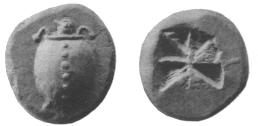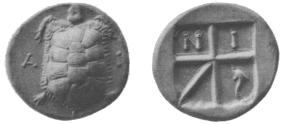
FIG. 218.



The island of Aegina was the earliest state in European Greece to adopt the use of coined money. Ancient tradition, which ascribed to Pheidon, king of Argos, the credit of having been the first to strike coins in this island, is perhaps due to the undisputed priority over all other coins of European Greece of the oldest staters of the Turtle type (Rev. Num., 1903, 359, n. 2). Unfortunately, however, there is much doubt about the date of Pheidon (Th. Reinach, Rev. Num., 1894, 1). As to the earliest Aeginetic coins there can be little doubt that they belong to about the middle of the seventh century. The principal ancient writers who mention Pheidon as
Whether the Aeginetic or Pheidonian standard was derived from the Phoenician, as the weights of some of the heaviest Aeginetic coins would lead us to suspect (B. V. Head, ‘Ancient Systems of Weight,’ Journal of the Institute of Bankers, 1879), or from Egypt, with which country the Aeginetans were in close relations (Herod. ii. 178), is doubtful; and Ridgeway’s solution of this problem is perhaps the true one, viz. that the Aeginetic silver standard was of independent origin, and based simply upon the relative value of gold and silver in Aegina when silver coins were first issued in that island. Supposing, as is highly probable, this relation to have been 15:1, a gold stater of Croesus or a daric of 130 grs. x 15 = 1,950 grs. of silver or 10 Aeginetic silver staters of 195 grs. (Ridgeway, Origin of Metallic Currency, p. 221). But the fact that the turtle, a creature sacred to Aphrodite (Frazer, Paus., vol. iv, p. 105), was chosen as the coin-type, lends some probability to the theory first advanced by E. Curtius (Num. Chron., 1870) that the Aeginetan mint was connected with the Temple of Aphrodite, which overlooked the great harbour of Aegina. The religious symbolism of the turtle as the παρασημον of Aegina is, however, disputed by Ridgeway (op. cit., p. 331).
The coinage of Aegina, like that of Athens, exhibits considerable uniformity of type, a uniformity which characterizes it as de facto an international, and not a mere local, currency. Throughout Peloponnesus the coinage of Aegina was, down to the time of the Peloponnesian war, the only universally recognized medium of exchange. This is implied by several passages in ancient authors, e.g. Pollux ix. 74 και μην το Πελοποννησιων νομισμα χεληνην τινες ηξιουν καλεισθαι απο του τυπωματος; Hesychius, χελωνη νομισμα Πελοποννησιακον.
By the Athenians the Aeginetic drachm was apparently called, in contradistinction to their own drachm, η παχεια δραχμη (Poll. ix. 76). Hesychius also says, λεπτας και παχειας Ζαλευκος εν νομοις τας δραχμας, λεπτας μεν τας εξωβολους, πα`cειας δε τας πλεον εχουσας: and πα`cgειη δρα`cμη το διδραχμον Αξαιοι.
From the weights of some exceptionally heavy specimens we gather that the Aeginetic stater originally weighed over 200 grs., and in the Bibliotheque Nationale, Paris, is a unique electrum stater, obv. Turtle, rev. Inc. square divided into two parts, weighing 207 grs. The date of this remarkable coin can hardly be much later than about B.C. 700. It belongs to the class of early electrum money struck on the Phoenician standard somewhat reduced. its type seems to connect it with Aegina, although the form of the incuse reverse points to an Asiatic origin. It
| Stater, | 194 grs. |
| Drachm, | 97 grs. |
| Triobol, | 48 grs. |
| Diobol, | 32 grs. |
| Trihemiobol, | 24 grs. |
| Obol, | 16 grs. |
| Hemiobol, | 8 grs. |
| Tetartemorion, | 4 grs. |
The following are approximately the chronological periods into which the money of Aegina falls (see Earle Fox in Corolla Num., pp. 34 sqq.).

| Sea-turtle (chelone caouana) with plain shell, and, later, with row of dots down the middle of its back (Fig. 218). | Incuse square divided into right triangular compartments, of which four or more are deeply hollowed out. AR Staters and divisions.
|
| Sea-turtle as above. [B. M. C., Att., Pl. XXIII. 4-12.] | Incuse square of ‘mill-sail’ pattern, often irregular in shape. AR Staters and divisions.
|
A rare variety of the stater exhibits the first attempt to indicate the plates on the carapace of the turtle (E. Fox in Corolla Num., Pl. I. 2 b).
| Sea-turtle with row of dots down back, and an additional dot on each side at front. [B. M. C., Att., Pl. XXIV. 4-7.] | Incuse square divided by broad bands into a conventional pattern of five compartments. AR Staters and divisions.
|
On these coins the original rough incuse square has already become a conventional pattern, maintained, there can be no question, not from
| Sea-turtle, as on the other coins of the period. [Ibid., Pl. XXIV. 8.] | Incuse square, within which triskeles, consisting of three human legs with large boss in the middle. AR 187.5 grs.
|
The triskeles on the reverse of this stater seems to point to a monetary alliance between Aegina and Phlius (see infra, p. 408, and J. P. Six in Num. Chron., 1888, p. 97). The fabric of this coin differs from that of the coins struck at the Aeginetan mint.
In B.C. 456 Aegina was made tributary to Athens; and in B.C. 431 the inhabitants were expelled en masse, and the island was occupied by Athenian kleruchs. During this period of semi-independence it would seem that no staters were issued. There are, however, triobols which may be assigned to this time.
| Sea-turtle, the structure of the shell indicated; to l. Λ, to r. Α. | Incuse square of conventional pattern; in one compartment, a crescent. AR Triobols.
|
During these twenty-seven years of the occupation of Aegina by the Athenians no coins with Aeginetan types appear to have been struck.
In B.C. 404, after the great defeat of the Athenians, Lysander restored the remnant of the Aeginetan population to their old homes, when they seem to have begun again to strike money. For some unexplained reason, however, the Sea-turtle, the obverse type of all previous coins, was at this time replaced by the Land-tortoise (testudo Graeca).
| Land-tortoise, the structure of the shell-plates clearly designed. On the later issues the letters Α Ι and added on either side of the tortoise. (Fig. 219.) [B. M. C., Att., Pl. XXV. 1-9.] | Shallow incuse square of the conventional pattern, the dividing bands usually thinner than on the older coins; on the later issues sometimes Α Ι, ΑΙΓ Ι, or abbreviated names of magistrates and a dolphin in the divisions of the square. AR Staters and divisions.
|

Towards the close of this period bronze coins began to supplant the smaller denominations in silver.
| Three or two dolphins, with Α in the midst. [B. M. C., Att., Pl. XXV. 10-14.] | Shallow incuse square of the conventional pattern, often with abbreviated names in the divisions. Æ .55
|
Shortly after Alexander’s time regal tetradrachms appear to have been struck in Aegina, with the tortoise and dolphin as symbols (Müller, 899). For the rest, Aegina in this period struck bronze money of various types :—
| ΑΙΓΙΝΑ Prow of galley. | Ram’s head. Æ .7.
|
| Α Ι Bucranium. | ΑΙ Dolphin. Æ .65
|
| Head of Zeus. [B. M. C., Att., Pl. XXVI. 1-5.] | ΑΙ ΓΙ ΝΙ Archaic Apollo walking with bow and branch (cf. Pausanias ii. 30, 1) Æ .65
|
Severus and family. Inscr. ΑΙΓΕΙΝΗΤΩΝ. Types :— Hekate. (Paus. ii. 30. 2.) Columnar Hermes. Hermes carrying a ram on his shoulders. The port of Aegina, indicated by a semicircular enclosure, in which is a galley, and above it a hexastyle temple or colonnade, in the midst of which is a flight of steps (Imhoof and Gardner, Num. Comm. on Paus., ii. 29. 6, Pl. L. 1). Aphrodite draped, holding branch and apple. Demeter. Athena. Nike. Poseidon. Aphaia (?) (Britomartis) standing by Zeus (Mus. Fontana, Pl. II. 7), see Pausanias, ii. 30. 3. Zeus holding eagle and fulmen (Paus. l. c.). Aeakos seated as judge of the dead. For other varieties see Imhoof and Gardner, op. cit.